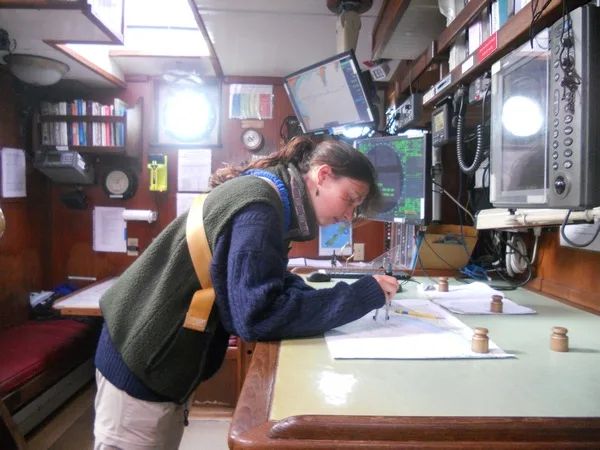Programs Blog
Leg 2 Begins

Author: Maggie Hannis, Middlebury College
Ship’s Log
8 December 2023Current Position: 39? 23.99’S, 177 37.33’EShip’s Heading and Speed: 102 ?, 6.5 knotsWeather: Mostly cloudy, calm seas, and a crisp force 4 east wind
Greetings from a few miles offshore!We departed Napier around 1000 this morning, and we’re fully back into the swing of things in terms of watch schedules and class time. It was a navigation-heavy day for me, a delight because navigation has become my favorite part of our daily watch obligations. Class time consisted of some lessons on celestial navigation; we learned how to shoot Local Apparent Noon on a sextant, which we can use to find our approximate line of latitude. Interestingly enough, sailors used to navigate using ONLY lines of latitude. Accurate measurements of longitude weren’t fully developed until the 17th century, so before that time sailors would pick a single line of latitude and tried to follow it straight until they hopefully reached their desired landmass. My own navigational endeavors today included working on some plotting in the chart room (pictured) and learning to use a Maneuvering Board to find the true wind speed and direction. Both were extremely easy to calculate during my watch time, considering we were motoring directly into the wind. Another highlight from my last couple of watches was my time spent as the student engineer. Although I didn’t learn much in terms of mechanical skills, I did pick up on some more sailing lore. Our engineer Abby showed me the ins-and-outs of the ship’s desalination system, and I was curious as to what ships did for fresh water before desalination technology existed. Apparently, they used to mix hard alcohol (usually rum) with the water stores onboard in order to keep it fresh enough to consume over the duration of a long journey. This is actually where we get the term “proof” from in relation to alcohol, because they would light these alcohol/water concoctions on fire, and if they ignited, this was proof, that the liquid was safe to drink. I am very pleased with the amount of sailing lore I’ve been learning on this trip. There seem to be infinitely many connections between modern lingo and old nautical terminology.I would love to rattle off some more sailing facts, but tiredness is setting in very quickly, so I’m going to end the post here. I don’t know what it is about the motion of the ocean that induces tiredness, but I’ve definitely been feeling it. Hoping for an exciting leg back to Auckland, with strong winds and some big swells!Maggie HannisA WatchMiddlebury CollegeP.S. Hello to my family onshore! I love and miss you all, try not to worry about me too much.
https://sea.edu/wp-content/uploads/2023/12/S312_8Dec2023_photo2_small.jpg
Recent Posts from the Ships
- Ocean Classroom 2024-A collaborative high school program with Proctor Academy
- Collaborations and Long-term Commitments: SEA’s Caribbean Reef Program Sets a Course for Coastal Programs that Compliment Shipboard Experiences.
- Sea Education Association students prepare for life underway using state of the art nautical simulation from Wartsila Corporation.
- SEA Writer 2022, Magazines From the Summer SEA Quest Students
- Technology@SEA: Upgrades Allow Insight into Ocean Depths
Programs
- Gap Year
- Ocean Exploration
- High School
- Science at SEA
- SEA Expedition
- SEAScape
- Pre-College
- Proctor Ocean Classroom
- Protecting the Phoenix Islands
- SPICE
- Stanford@SEA
- Undergraduate
- Climate and Society
- Climate Change and Coastal Resilience
- Coral Reef Conservation
- Marine Biodiversity and Conservation
- MBL
- Ocean Exploration: Plastics
- Ocean Policy: Marine Protected Areas
- Oceans and Climate
- Pacific Reef Expedition
- The Global Ocean: Hawai'i
- The Global Ocean: New Zealand